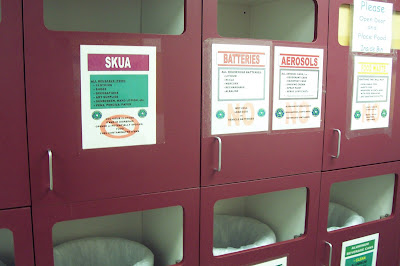 All of the trash from McMurdo Station has to be shipped back to California. That's because they found that the garbage they used to put in the ocean or bury doesn't disintegrate because of the cold. Back in 1991-91, Pat was here as an engineer building an incinerator, but that was abandoned because burning was frowned upon. This picture is taken from the Waste Department, where they sort every piece of trash and prepare it for shipment back to the US. Some of it for obvious reasons gets frozen for the trip. In the background is the spectacular ocean and mountains.
All of the trash from McMurdo Station has to be shipped back to California. That's because they found that the garbage they used to put in the ocean or bury doesn't disintegrate because of the cold. Back in 1991-91, Pat was here as an engineer building an incinerator, but that was abandoned because burning was frowned upon. This picture is taken from the Waste Department, where they sort every piece of trash and prepare it for shipment back to the US. Some of it for obvious reasons gets frozen for the trip. In the background is the spectacular ocean and mountains. There is a wonderful tradition of recycling useable clothes and goods here called Skua. It's named after a scavenger bird, called the Skua. There are two nesting pairs here, and the story is that the same birds come back year after year. They know where people come out of the dining room with plates of food. I met my first one flying right in front of my face as it was checking out what was in my hands. It turned out to be my mittens, so it didn't stick around. Notice that the bird is about the same color as the soil, which is volcanic rock.
There is a wonderful tradition of recycling useable clothes and goods here called Skua. It's named after a scavenger bird, called the Skua. There are two nesting pairs here, and the story is that the same birds come back year after year. They know where people come out of the dining room with plates of food. I met my first one flying right in front of my face as it was checking out what was in my hands. It turned out to be my mittens, so it didn't stick around. Notice that the bird is about the same color as the soil, which is volcanic rock. There are "skua bins" in every building. Everyone is expected to sort their trash into food, recyclable paper, non-recyclyable paper (papertowels), plastic, glass, aluminum cans, other metal, etc. In our dorm there are 14 different bins. The janitors empty the bins and take everything to the Waste Dept or to "Skua Central," the building where all reusable items are available for anyone to take.
There are "skua bins" in every building. Everyone is expected to sort their trash into food, recyclable paper, non-recyclyable paper (papertowels), plastic, glass, aluminum cans, other metal, etc. In our dorm there are 14 different bins. The janitors empty the bins and take everything to the Waste Dept or to "Skua Central," the building where all reusable items are available for anyone to take.
Skua Central is like a free Goodwill store. You just take anything you like. Most people here dress in Skua clothes, because the work here can be hard on personal clothes. I have several pairs of Skua jeans, and some shirts.
 Finding parts for work can be a scavenging operation as well. Some parts locations are very well documented. Others, such as nuts and bolts, tend to be just thrown together. This makes me miss having a local hardware. It also makes me think of a hardware store employee who was listening to an old guy complain about the price of a screw. "Why, that's robbery. I have 20 of those at home," grumbled the old man.
Finding parts for work can be a scavenging operation as well. Some parts locations are very well documented. Others, such as nuts and bolts, tend to be just thrown together. This makes me miss having a local hardware. It also makes me think of a hardware store employee who was listening to an old guy complain about the price of a screw. "Why, that's robbery. I have 20 of those at home," grumbled the old man. "Yes," replied the employee very nicely,"but you can't find them, can you?" Here we find them eventually. When I get frustrated about how long it takes to find a part, I add up how long it would take me to drive to the hardware store at home and back, and decided that it's probably faster rummagine through the misc parts drawers in three buildings here! And there's no traffic congestion. In fact, no traffic!


















